Seiko’s legacy in the world of precision timekeeping is both rich and enduring, tracing its roots back to the 1964 Tokyo Olympics, where the brand served as the official timer for the first time. This pioneering effort led to the development of revolutionary stopwatches and a commitment to precision that would define the company for decades to come. This foundation in sports timing technology is the very essence of the Prospex line, a name derived from the words “Professional Specifications,” which signifies a dedication to creating durable, reliable, and practical timepieces for the most demanding environments.
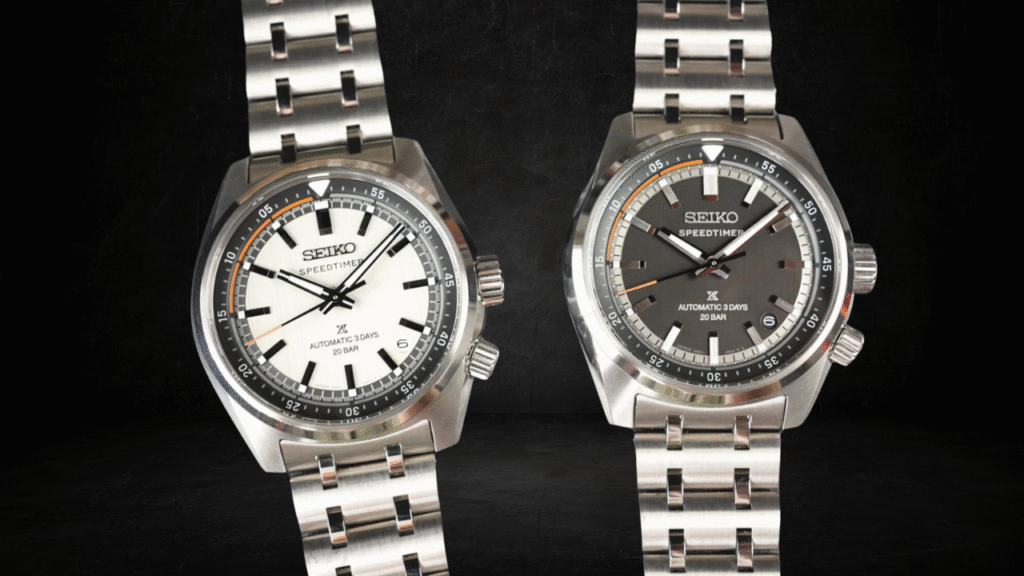
It was this same spirit of technical advancement that led to a pivotal moment in 1969. In what became a historic race against Swiss competitors, Seiko introduced the “5 Speed-Timer,” the world’s first commercially available automatic chronograph, equipped with the innovative Caliber 6139. Coincidentally, this was the same year that the Datsun 240Z, a high-performance sports car, was released to international acclaim. A natural partnership was born, and by 1971, the Seiko logo was emblazoned on the Datsun 240Z as it raced to victory in the East-African Safari Rally. This shared heritage of technical innovation and motorsports is now celebrated with the new Datsun-themed limited edition SPB517, setting the stage for the two main subjects of this analysis.
The new Seiko Prospex Speedtimer SPB513 and SPB515 are a testament to this deep-rooted history, blending vintage-inspired design with modern engineering in a refined everyday sports watch. While their brethren in the Speedtimer line are chronographs, these new references take a different approach. The SPB513 and SPB515 capture the retro charm of the 1972 Speedtimer silhouette but depart from the traditional chronograph complication, opting instead for a practical time-and-date format with a versatile inner countdown bezel. This decision represents a new chapter for the Speedtimer family, introducing a model that is both a tribute to the past and a highly functional timepiece for the modern enthusiast.
Design & Heritage
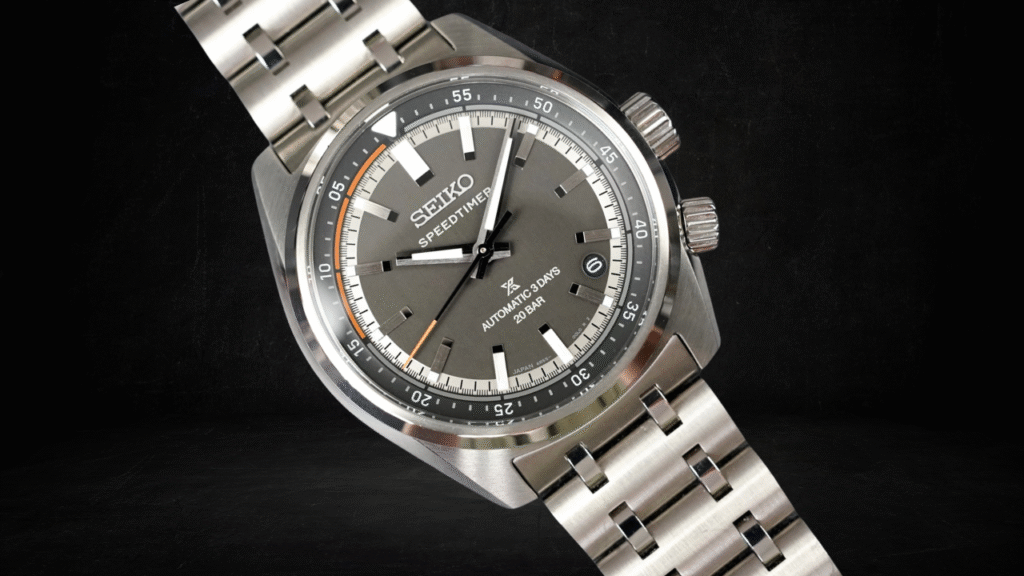
The physical form of the SPB513 and SPB515 is where the blend of past and present is most apparent. The watches maintain balanced and compact proportions with a 39.5mm diameter and a thickness of just 12.0mm. This sizing is a strategic choice, appealing to a contemporary audience that has increasingly moved away from the oversized watch trend of the last decade. The modest dimensions, combined with a lug-to-lug distance of 44.5mm, ensure that the watches wear comfortably on a wide range of wrist sizes, making them a highly versatile daily-wear option. The case design stays faithful to the original 1972 Speedtimer, a model that was famously nicknamed “Panda” by fans due to its high-contrast dial.
A defining feature that elevates the case’s practicality is Seiko’s super-hard coating. This treatment is a type of hard ceramic coating, also known as Diashield, which is applied to the stainless steel using a Physical Vapor Deposition (PVD) process. The coating is designed to resist the accumulation of everyday scuffs and micro-scratches, ensuring the watch maintains a “mint” appearance for years to come. This directly addresses a significant source of frustration for watch owners, as many highly polished stainless steel watches quickly show signs of wear from daily activities like “desk diving”. The super-hard coating provides a layer of resilience that standard steel cannot match, making the watch a true “go-anywhere-do-anything” piece without the common aesthetic degradation. However, this durability comes with a specific trade-off: unlike untreated steel, a coated watch cannot be easily refinished to remove deeper scratches or dents, a point that is often discussed among collectors who value the ability to restore a watch to its original condition.
The Countdown Dial
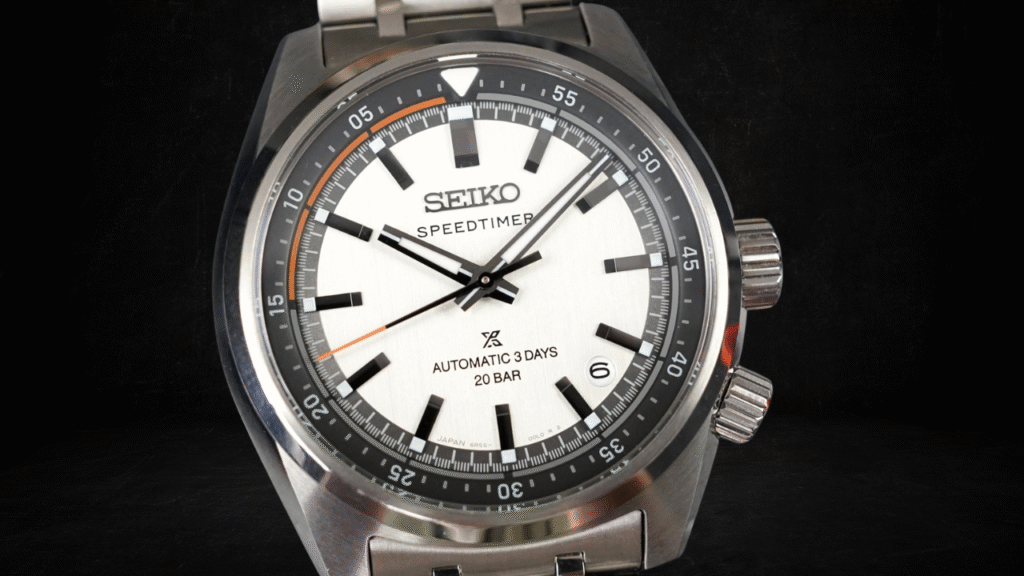
The dial of the SPB513 and SPB515 is a masterclass in clean, functional design. Both the silver-white dial of the SPB513 and the black dial of the SPB515 feature crisp and legible layouts with sharp hands and markers. A subtle yet striking visual cue is the pop of orange on the tip of the central seconds hand and the final 15 minutes of the inner countdown bezel, a direct design element inherited from the 1972 Speedtimer. This splash of color adds a sporty touch while enhancing legibility for quick measurements. A curved sapphire crystal with an inner anti-reflective coating further ensures clarity under bright light, a crucial detail for a sports watch.
In place of the traditional chronograph sub-dials, the SPB513 and SPB515 feature a bidirectional inner rotating countdown bezel operated by an additional crown at 4 o’clock. While this may seem a departure from the “Speedtimer” name, it provides a highly useful and intuitive timing function. As Seiko explains, the bezel can be used for “critical moments” and to track “crucial intervals”. Its application extends beyond motorsports, serving practical everyday purposes like timing a lunch break or ensuring pasta is cooked perfectly “al dente”. The inclusion of this feature reinforces Seiko’s commitment to creating tool watches with genuine, real-world utility, even when the complication is not a chronograph. This accessible functionality is a key part of the watch’s appeal, showcasing a pragmatic design philosophy.
The Multi-Row Bracelet
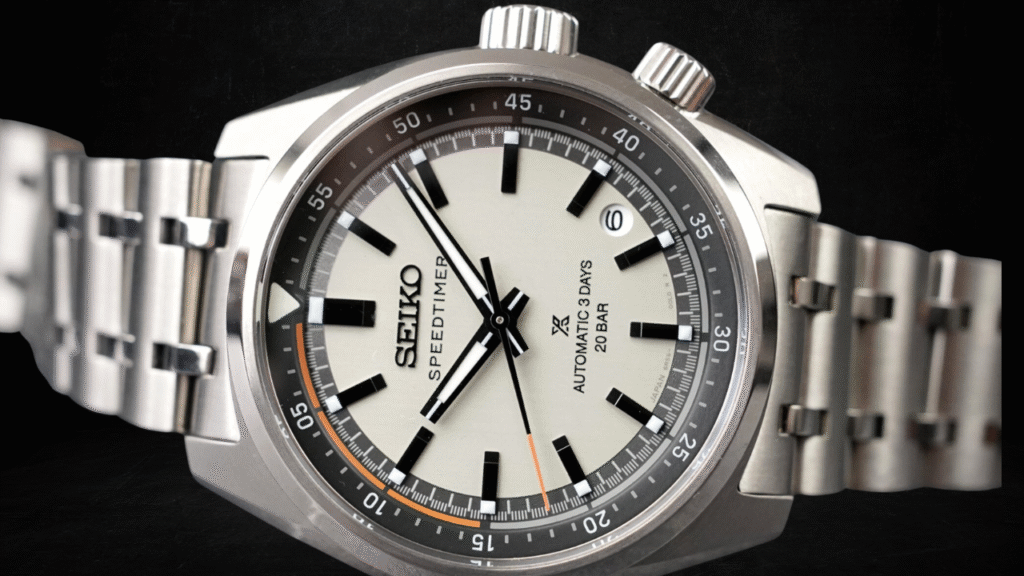
The new references are presented on a vintage-style multi-row stainless steel bracelet that perfectly complements the watch’s aesthetic. The bracelet is designed for both comfort and security, featuring a three-fold clasp with a push-button release. The multi-row design, sometimes referred to as a Jubilee-style bracelet, is a deliberate choice that contributes to the watch’s refined appearance and wearing experience.
This design decision is not merely cosmetic. The smaller, more articulated links of a multi-row bracelet conform more easily to the wrist, often providing a more comfortable and elegant fit than a standard three-link bracelet. It positions the SPB513 and SPB515 not just as rugged sports watches but as versatile timepieces that can be worn in a variety of settings. This detail is an example of Seiko’s meticulous attention to combining retro charm with modern practicality, ensuring the watch feels as good on the wrist as it looks.
Key Technical Specifications
| Feature | Seiko Prospex Speedtimer SPB513 / SPB515 |
| Reference | SPB513 (Silver-white dial), SPB515 (Black dial) |
| Case Material | Stainless steel with super-hard coating |
| Case Diameter | 39.5mm |
| Thickness | 12.0mm |
| Lug-to-Lug | 44.5mm |
| Water Resistance | 200m / 20 bar |
| Movement | Calibre 6R55, Automatic with manual winding |
| Power Reserve | 72 hours |
| Magnetic Resistance | 4,800 A/m |
| Price | EUR 1,000 |
The Calibre 6R55 Movement: Precision and Endurance
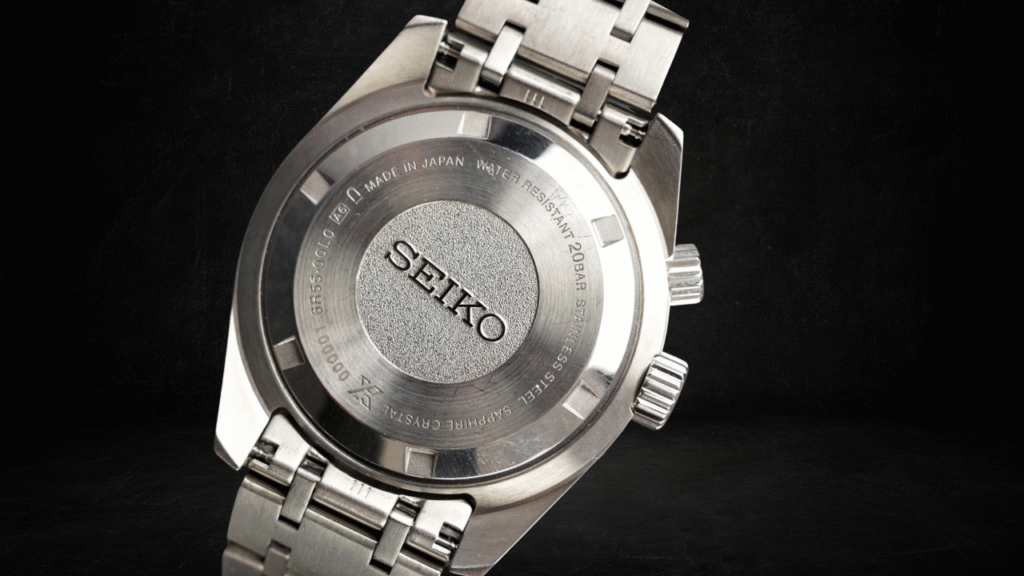
At the heart of the new Speedtimer references lies the Calibre 6R55, an in-house automatic movement that has become a staple in Seiko’s mid-to-high-end collections. The movement operates at a frequency of 21,600 vibrations per hour (3 Hz) and contains 24 jewels. As an evolution of the widely respected 6R15 and 6R35 calibers, the 6R55 represents Seiko’s ongoing commitment to innovation and reliability. Its presence in models within the Presage Luxe and King Seiko collections underscores its quality and elevated status within the brand’s mechanical offerings. This choice of movement signals that these Speedtimers are not merely an exercise in vintage styling but are built with robust, modern mechanics designed for long-term performance.
The Three-Day Power Reserve
A standout feature of the Calibre 6R55 is its impressive 72-hour power reserve. This means the watch can be left unworn for a full three days—a common scenario over a weekend—and still be running accurately on Monday morning. This feature is a crucial modern convenience that significantly enhances the user experience. Many entry-level automatic watches offer a power reserve of only around 40 hours , which often requires the wearer to manually wind the watch or reset the time after a short period off-wrist. The 72-hour power reserve of the 6R55 eliminates this friction, making the watch a true and hassle-free “daily driver” that is “robust enough for daily life and weekend drives”. This practical advantage is a powerful value driver that directly appeals to a user who appreciates reliability and ease of use.
2.3. The Accuracy of Calibre 6R55
The official precision rating for the Calibre 6R55 is a range of +25 to -15 seconds per day. This specification is a frequent point of discussion and, at times, criticism among watch enthusiasts who compare it to the tighter tolerances of Swiss counterparts. However, this official rating is often misunderstood. The figure represents a conservative, minimum standard that Seiko guarantees under various conditions.
In reality, the performance of the Calibre 6R55 in the real world is consistently reported to be far better. As many owners and reviewers have noted, the actual accuracy achieved is often significantly tighter than the quoted range. This dynamic of officially under-promising and anecdotally over-delivering has cultivated a positive reputation for the movement within the watch community. For the average buyer, this translates to a pleasant surprise, as their new timepiece performs more accurately than the specifications might suggest. This contributes to the watch’s strong reputation and word-of-mouth appeal, solidifying its place as a reliable and high-value choice.
Why a Non-Chronograph is Called a Speedtimer
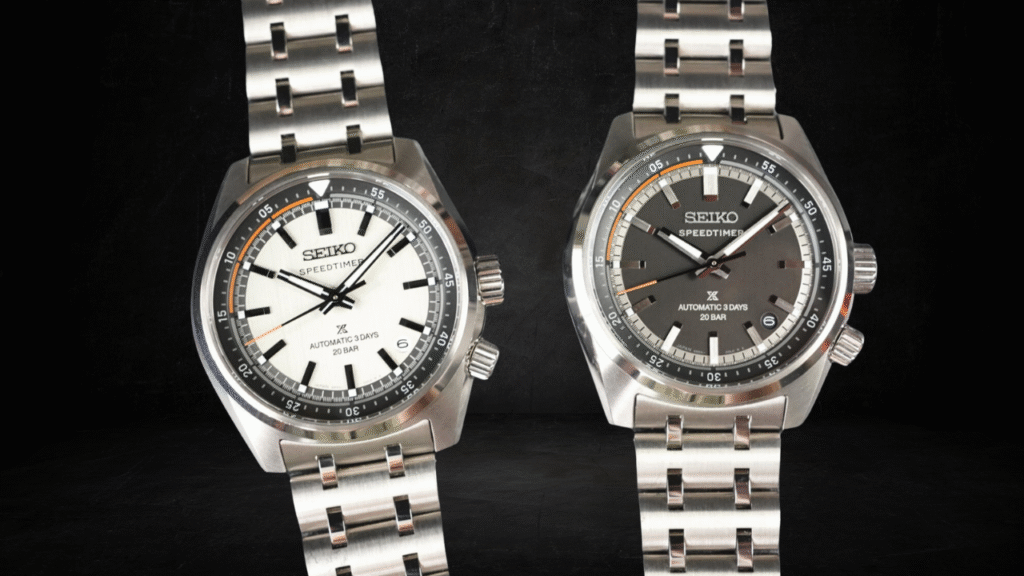
The most significant point of contention among enthusiasts regarding the new SPB513 and SPB515 is their name. The “Speedtimer” collection has, for decades, been synonymous with Seiko’s flagship chronographs, from the groundbreaking 6139 of 1969 to the modern 8R series. The introduction of a time-and-date watch, even with a countdown bezel, under this revered name has led to a great deal of confusion and debate. Many purists argue that without the chronograph complication, the watch is not a “true” Speedtimer, and some have called Seiko’s decision a confusing departure from its heritage.
Seiko has, however, provided an explanation for this expansion of the Speedtimer moniker. The brand has broadened the definition of the line to encompass all “motorsport-inspired tool watches” and “racing-inspired wristwatches,” not just chronographs. The integrated inner countdown bezel, a central feature of the SPB513 and SPB515, is presented as a functional nod to the world of racing, where such timers could be used to track intervals like pit stops or a starting countdown.
This naming decision is not an oversight but rather a calculated brand strategy. By leveraging the high-volume keyword and established heritage of the “Speedtimer” name, Seiko can introduce a new, versatile product line to a much broader audience than a niche-focused collection might attract. This move is designed to expand the collection’s appeal beyond the enthusiast who specifically seeks a chronograph.
The controversy itself has become a tool for organic marketing. The debates and discussions on forums and social media platforms surrounding the naming choice have generated significant online attention for the new models. While some of the sentiment may be negative, the sheer volume of conversation drives a high level of brand awareness and search engine visibility. This demonstrates a sophisticated understanding of modern digital marketing, where even perceived missteps can be leveraged to generate interest and visibility. The ultimate outcome is a new, continuous-production model that benefits from the strong, established reputation of the Speedtimer name, making it a compelling choice for a wide audience.
The Value Proposition & Market Positioning
The Seiko Prospex Speedtimer SPB513 and SPB515 are priced at EUR 1,000. This price point places them in a highly competitive segment of the market but also positions them as an exceptionally strong value proposition. When viewed through the lens of their technical specifications and features, the cost is well justified. The watch boasts an in-house automatic movement with a 72-hour power reserve, 200m water resistance, and the highly effective super-hard coating. These are features typically found in watches at a much higher price point. The synthesis of these elements presents a compelling argument for its value, making it “a seriously complete watch” that offers “real-world functionality” and “solid modern engineering”.
A Comparative Analysis
To truly understand the value of the SPB513 and SPB515, a comparison with its key rivals in the ~€1,000-€1,500 range is essential. These watches often compete for the attention of a consumer seeking a versatile, high-quality timepiece that blends heritage with modern sensibilities.
- vs. Tissot PRX Powermatic 80: The Tissot PRX is a sensation, known for its integrated bracelet design and 80-hour power reserve. While the PRX captures a distinctly 1970s aesthetic, the Seiko offers a different kind of vintage charm with its traditional case and multi-row bracelet. The Seiko’s 200m water resistance and super-hard coating arguably give it a functional edge in terms of durability and aquatic versatility compared to the PRX’s 100m rating.
- vs. Christopher Ward C63 Sealander GMT: Christopher Ward is a microbrand favorite known for offering incredible value. The C63 Sealander GMT, with its Swiss movement and GMT complication, presents a different type of utility for the globetrotter. However, the Seiko’s in-house Calibre 6R55 holds a certain horological prestige that some enthusiasts value over a modified Swiss movement.
- vs. Sinn 104 St SA: Sinn is renowned for its functional, tool-watch philosophy. The Sinn 104 is a pilot’s watch with a hardened steel case, offering a different approach to scratch resistance compared to Seiko’s PVD-based coating. The Sinn’s aesthetic is more overtly utilitarian, whereas the Seiko leans into a more elegant and refined motorsport-inspired design.
| Watch Model | Case Size | Movement Type | Power Reserve | Key Features | Price (approx. EUR) |
| Seiko SPB513/515 | 39.5mm | In-house Automatic (Calibre 6R55) | 72 hours | Super-Hard Coating, 200m WR, Inner Countdown Bezel | 1,000 |
| Tissot PRX Powermatic 80 | 35mm, 40mm | Swiss Automatic (Powermatic 80) | 80 hours | Integrated Bracelet, Wide Color Range | 775 |
| Christopher Ward C63 Sealander GMT | 36mm, 39mm | Swiss Automatic (Sellita SW330) | 38 hours | GMT Functionality, High-Value Offering | 1,410 |
| Sinn 104 St SA | 41mm | Swiss Automatic (Sellita SW220) | ~38 hours | Hardened Steel, Pilot’s Watch Aesthetic | 1,450 |
Final Verdict
The consensus from both expert reviews and owner feedback is overwhelmingly positive. While some enthusiasts may initially find the EUR 1,000 price “a little steep,” they often concede that the watch’s combination of features and quality justifies the cost. The SPB513 and SPB515 are lauded for their comfort, versatility, and the ability to compete with much more expensive watches from brands like Tudor and Longines. Owners have described it as “an amazing watch and probably one of the best watches under a k,” and a perfect “all round watch” that gets significant wrist time. The watch is not just a collection of impressive specifications but a complete package that offers a compelling mix of history, real-world functionality, and solid modern engineering.
The Seiko Prospex Speedtimer SPB513 and SPB515 represent a pivotal moment for the collection. By moving beyond the traditional chronograph, Seiko has created a new category of “Speedtimer” that is more versatile, practical, and accessible for the everyday wearer. The watch is a masterclass in blending vintage charm with modern durability, thanks to its compact dimensions and super-hard coating. Its in-house Calibre 6R55 movement, with its convenient 72-hour power reserve and reliable performance, solidifies its position as a serious contender in the competitive sub-€1,500 market.
This watch is not for the purist who demands a chronograph in a Speedtimer, but for the discerning individual who appreciates a rich brand history and seeks a high-quality, durable, and elegant daily-wearer. The SPB513 and SPB515 are a testament to Seiko’s ability to innovate while honoring its legacy, proving that the spirit of a motorsports icon can be captured in a timepiece that is ready for any challenge, whether on the track or in daily life.
You may also like: Hamilton Khaki Field Power Reserve Mechanical 40mm Review




